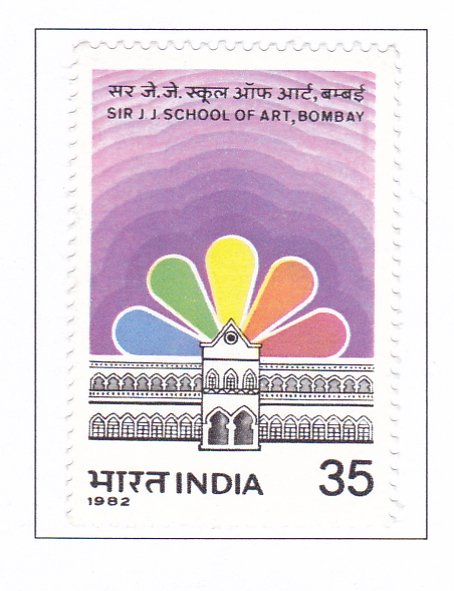125th Anniversary of Sir J. J. School of Art, Bombay

Technical Data
| Date of Issue | March 2, 1982 |
|---|---|
| Denomination | 35 p |
| Quantity | 2,000,000 |
| Perforation | comb 14 x 14½ |
| Printer | Security Printing Press, Nashik |
| Watermark | No Watermark |
| Colors | Multicolor |
| Catalog Codes |
Michel IN 901 Stamp Number IN 952 Yvert et Tellier IN 702 Stanley Gibbons IN 1036 |
| Themes | Anniversaries and Jubilees | Buildings | Schools |
The year 1857 marked a significant milestone in Indian history with the establishment of the Sir J. J. School of Art, made possible by a generous donation of Rs. 1,00,000 from Sir Jamshedji Jeejibhoy, the first Baronet. Initially, the school began with the first drawing class held at the Elphinstone Institute, managed by a committee led by the Chief Justice of Bombay. In 1866, the school expanded with the establishment of three ateliers for Decorative Paintings, Modelling, and Ornamental Wrought Iron Work, under government management.
By 1878, the school had moved to its present building, and drawing teaching was introduced in 1879, with facilities for training Drawing Teachers initiated in 1893. The institution also focused on the development of indigenous arts and crafts, with notable efforts including the copying of Ajanta murals by Mr. Griffiths and J. J. students, showcasing the first pictorial record of these murals to the public.
The school’s Modelling atelier contributed ornamental details to various buildings in Bombay, including the Victoria Terminus and University Building. In 1891, the Lord Reay Art Workshops, now known as the Department of Art-Craft, were established, followed by the addition of Draughtsman’s classes in 1896, which later evolved into the Department of Architecture offering a recognized Diploma Course.
In 1910, Sir George Clark’s Studies and Laboratories were established for advanced craft study, with pottery produced gaining recognition in international exhibitions. The school underwent administrative and academic changes post-independence in 1947, with the appointment of its first Indian Director, Shri V.S. Adurkar. In 1958, the Sir J.J. Institute of Applied Art was established, separating the Departments of Architecture and Applied Art.
In its 125th year, the Sir J.J. School of Art continues to contribute significantly to the cultural development of India, producing painters, sculptors, architects, and graphic designers whose works garner praise both nationally and internationally. Notable contributions include murals at the Secretariat complex in New Delhi and the National Defence Academy, Khadakwasla, as well as the bronze cast of the Ashok Emblem at the dome of the New Council Hall in Bombay.
The Indian Posts & Telegraphs Department is honored to issue a commemorative stamp celebrating the 125th Anniversary of this esteemed institution, recognizing its pivotal role in nurturing artistic talent and cultural heritage.
